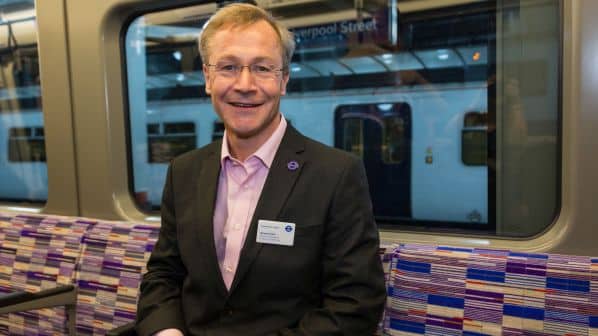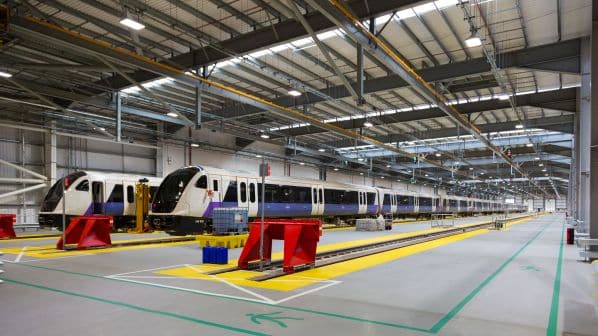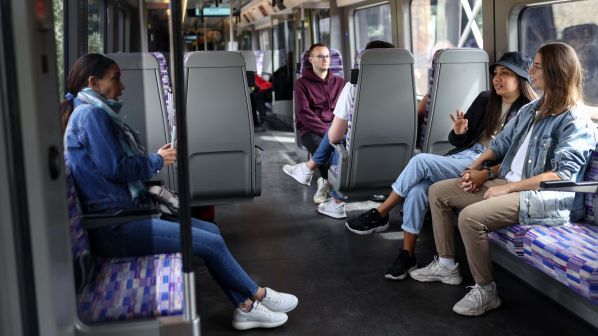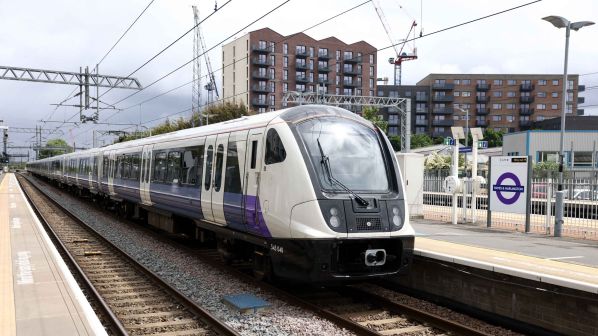THE long-standing Crossrail project to build an RER or S-Bahn style east-west railway under London finally came to fruition on May 21 this year when the full timetable was introduced on what has been renamed the Elizabeth Line, offering passengers up to 24 trains per hour on the central underground core between Paddington and Whitechapel. From Whitechapel, Elizabeth Line trains run on new infrastructure, mainly in tunnel, to Canary Wharf, Woolwich and Abbey Wood in southeast London, or in tunnel to Pudding Mill Lane to join the Great Eastern Main Line (GEML) and then continue eastwards on the surface to Stratford, Romford and Shenfield.
The western portal of the central core is at Westbourne Park just outside Paddington, and from here Elizabeth Line trains take the Great Western Main Line (GWML) to Reading, or the branch to Heathrow Airport where the Elizabeth Line serves all three stations within the airport complex.
It has not been an easy task to combine new underground infrastructure with existing commuter routes to create this new network, while introducing to Britain’s National Rail network new technology such as ATO on CBTC and platform screen doors. But Mr Howard Smith, Elizabeth Line director at Transport for London (TfL), is clearly pleased with the results of the first year of operations on the new line since it first opened on May 24 2022.
“It’s not been without its challenges and moments,” he says, “but over the last year we have opened what we said we would when we said we would, and the people have come flocking, really, really big time.” So much so that on June 15 the Elizabeth Line recorded 685,000 passenger-journeys, its busiest day ever while reflecting changes in London commuting habits since the Covid-19 pandemic where Thursday is now the busiest day of the week.
TfL says that the Elizabeth Line “has already become one of the most used railways in the country” and has notched up over 155 million passenger-journeys since May 24 2022, and is now recording an average of 3.5 million passenger-journeys a week since the full timetable was introduced on May 21. Meaningful comparison with other operators is complicated by an issue with the industry database used to calculate the official passenger usage statistics published by the Office of Rail and Road (ORR), which has resulted in national and Elizabeth Line passenger-journey totals being overestimated. With this caveat, ORR says that of the national total of 1.4 billion passenger journeys in 2022-23, the Elizabeth Line accounted for 200 million. This compares with 300 million at Govia Thameslink Railway, 100 million at Southeastern and 100 million at South Western Railway, all three major London commuter operators with larger networks and longer routes.
“It’s not an optical illusion,” Smith says. “670,000 passengers a day is a very significant proportion of National Rail passengers in Britain. One in eight journeys on National Rail is made on the Elizabeth Line, so it’s extraordinarily busy.” And internally at TfL, he says the preference is to concentrate more on the figures for passenger revenue rather than passenger-journeys, “because that’s real money that we really get.”
“It’s an enormous generalisation, but effectively the Crossrail project organisation did a good job of the civil works and the tunnelling, and then effectively missed the step-change to systems and delivering an operational railway and bringing it all together.”
Howard Smith
TfL says that the Elizabeth Line is “on track to break even by the end of the 2023-24 financial year,” which according to Smith means that it will cover its direct operating costs, a rare situation for a commuter network. “It won’t have covered any of its capital costs,” Smith says. “If we look forward to long-term renewals, we’re probably not covering those at the moment. But we are covering the cost of traincrew, rolling stock, station staff, electricity and maintenance, day-to-day operating costs.
“That’s not a surprise. It should be a very efficient railway.”

As well as modern equipment and staffing practices, Smith points to the larger towns that the Elizabeth Line serves, such as Reading and Maidenhead, as well as employment centres and leisure destinations in the West End and City of London, the Canary Wharf business district, and Stratford which is home to the Westfield shopping complex “where everybody goes now.”
“The Elizabeth Line is not a classic radial service which carries fresh air in most directions for part of the day,” Smith says. “The traffic is very well balanced.” One example is commuter traffic from Reading to London being complemented by inverse commuting from Maidenhead to Reading, an opportunity to pick up “some decent traffic going the other way” that would have been missed had the original plans for Crossrail not been amended to make Reading its western terminus rather than Maidenhead.
Systems integration challenge
The completed Elizabeth Line is now acting as a case study for operators and other transport organisations. “This is the first time since the OIympics in 2012 that I’ve experienced people coming to London from all over the world to see a piece of railway infrastructure,” Smith says, reporting official visits from Europe, Australia and New Zealand in the past year as well as by the Ministry of Transportation of Ontario in Canada and US passenger operator Amtrak. “It’s not just what you might call the usual suspects, it has actually been people from a really wide range of organisations,” Smith says. “What they’re interested in is why did it get very hard when we started putting the systems in and how do they avoid the same sort of challenges.”
“It’s an enormous generalisation, but effectively the Crossrail project organisation did a good job of the civil works and the tunnelling, and then effectively missed the step-change to systems and delivering an operational railway and bringing it all together,” Smith says. “That was effectively bolted on from 2018 onwards and has been ultimately successful, but it obviously would have been even better if we’d have picked up that phase in 2017.
“The signalling had its moments, but it wasn’t the specific systems themselves that caused the problem, it was effectively the failure to recognise the challenge in terms of integration.” Smith also points to what he terms “the utterly unforgiving nature of linear systems,” the challenge of delivering an operating railway that works as a whole, end to end.

The Elizabeth Line fleet of class 345 Aventra EMUs operates under ETCS, CBTC and legacy signalling systems on the GEML and GWML, including the AWS and TPWS train protection systems. “ETCS is effectively the master of the system and then it chooses the Specific Transmission Module (STM), of which we’ve got three,” Smith explains. ETCS Level 2 itself is only in operation on the branch from Heathrow Airport to Stockley Junction where it joins the GWML, but is due to be extended further east to Acton Main Line this autumn. “The plan for years has been to extend through to Paddington,” Smith says.
Siemens Trainguard CBTC has been installed from Westbourne Park to Pudding Mill Lane and on the entire southeastern branch from Whitechapel to Abbey Wood. Transition between the legacy signalling and CBTC is automatic, so on the approach to Stratford or Westbourne Park, the driver is offered CBTC, accepts it and the train is then operated in ATO. “That is a system that works remarkably well,” Smith says “It has to work remarkably well, because when it doesn’t work, it leaves you with a fundamental problem.”
Should a train fail to transition on the GEML, it can continue on the surface to Liverpool Street where platforms were extended to accommodate full-length class 345s. These platforms are also used by scheduled Elizabeth Line services from Gidea Park to Liverpool Street, where some passengers prefer to use the surface platforms as they are closer to their place of work. Diverting to Liverpool Street “is not great, but it’s almost pretty painless,” Smith says, unlike at Westbourne Park where a train unable to transition to CBTC must be diverted into Paddington, unloaded and sent back out again, which Smith describes as a “very painful” activity. “We’ve only had a handful of instances when that’s happened,” he reports, but train preparation procedures undertaken by fleet maintenance contractor Alstom at Old Oak Common have been recently changed to ensure the availability of CBTC is more actively checked before the trains enter service.
The Trainguard CBTC system generally works very well, Smith reports, the less robust aspects being the timetable processor and the modifications required for operating in an S-Bahn/RER environment rather than on a self-contained metro, such as working with the headcodes used to identify trains under legacy signalling systems and interfacing with the passenger information system in operation throughout the Elizabeth Line.
“It’s the customisation that’s been the challenge and the train,” Smith says. “From the moment we start putting more and more of the signalling equipment on the train, the train actually becomes the heart of integrating almost the whole railway.” The complexity of onboard systems and their software is reflected by the fact that the Elizabeth Line fleet is currently achieving comparatively low reliability scores, as measured in miles per technical incident (MTIN) causing a delay. “You would have thought it was completely impossible to run the service that we do now with trains that are about 10,000 MTIN. It is one of the big issues to get the service more reliable,” Smith says.
In Period 2 of 2023-24 from April 30 to May 27 the fleet reliability score was 9278 MTIN.
The train service can be maintained on the Elizabeth Line with the fleet in this condition because faulty systems can be reset in three or six minutes, rather than causing prolonged delays as might have been the case with less sophisticated rolling stock in the past. Smith notes that under its fleet maintenance contract, Alstom is “very, very heavily incentivised” by the penalty payments it has to make for not meeting reliability targets.
“We’d rather not have the money, we’d rather have the reliability,” he says, adding that both Alstom and Siemens have been working collaboratively to resolve these problems, and especially the remaining issues that lie mostly at the interface between the onboard CBTC hardware and the Alstom Train Control and Management System (TCMS). “Even this week, as we do quite regularly now, we had a team of Siemens engineers and a team of Alstom engineers in the office for an all-day meeting, sorting through the priorities and looking at the biggest improvements they could make,” Smith says.
“Despite the money spent on electrification, some of the rest of the infrastructure is more fragile than it should be.”
Howard Smith
The other major issue to be resolved to reduce delays for Elizabeth Line passengers is infrastructure reliability on the GWML, managed by Network Rail. The arrival of the intensive Elizabeth Line service on the GWML was “always going to be a challenge,” Smith says. While the GEML has had frequent electric commuter services for some years, which do not have to share the slow lines with freight trains (these use the fast lines on the GEML), the GWML had a much less frequent diesel commuter service until comparatively recently, sharing the slow lines with freight that includes major flows of aggregates from the west of England.
“Everybody’s always recognised it was going to be a huge cultural and service change, which isn’t quite there yet on the GWML,” Smith says. “Despite the money spent on electrification, some of the rest of the infrastructure is more fragile than it should be.” The four freight paths an hour on the GWML slow lines are fully taken up at busier times of the day, and between April 3 and June 9 there were twice as many freight trains on the GWML between Reading and London, due to the closure for emergency repairs of Nuneham Viaduct on the route via Oxford to the north of England. “In terms of both delaying services and preventing us from doing tricks, like skipping some station stops to recover delays elsewhere, it was pretty tricky,” Smith says. “If you look at both where the delays arise, but also the opportunities for the future, they are very predominantly in the fleet and in the GWML.”
Phased opening programme
Passenger operations on the Elizabeth Line started on May 24 2022, with 12 trains an hour operating from Abbey Wood to Paddington, alongside existing services into Paddington on the GWML and Liverpool Street on the GEML. On November 6 2022 trains started running from Shenfield on the GEML to Paddington, and from the GWML to Abbey Wood, increasing the service between Paddington and Whitechapel to 22 trains an hour.
“The advantage of doing that was that we didn’t have to turn 24 trains an hour at Paddington, which would always have been a juggling act,” Smith says. “The disadvantage was that you’ve got the two overlapping services that can disrupt each other.” The final phase of the opening programme on May 21 saw through services introduced from Heathrow Terminal 5 to Shenfield, the peak frequency between Paddington and Whitechapel increased to 24 trains an hour, and the length of both the morning and evening peak extended.
The full Elizabeth Line timetable was made possible by the introduction of auto reverse, which effectively sees the train drive itself from Paddington to the turnback sidings at Westbourne Park, complete all the procedures for reversing - including testing signalling and other onboard systems - and then proceed in the other direction back towards Paddington “while the driver is walking through the train and without any human intervention,” Smith points out.
“That’s now fully in service and used by 107 trains a day. It has worked well but it’s not perfect yet. The remaining issues are at the margins, they’re timing issues between Siemens and Alstom for individual components that they’re adjusting at the moment. But generally speaking, auto reverse is much more of a help than a hindrance even now, and once we’ve tweaked a few things, we’ll wonder how we managed without it.”

Auto reverse enables the Elizabeth Line to operate six trains an hour to Heathrow Airport. “It’s an incredibly busy bit of railway and picking up really good business,” Smith says. “Although we’re working through the statistics, we believe we are now moving more people in and out of the airport than Heathrow Express, and that’s only ever going to go one way.” Anecdotal evidence suggests that the Elizabeth Line is also picking up “quite a bit of business” at Abbey Wood from passengers changing from Southeastern services to reach central London. “In the west, the residual Great Western Railway services have now effectively become non-stop to and from Slough, so we’ll have picked up quite a lot of business. We’re effectively the GWML suburban operator now.”
Further growth in the immediate future should be absorbed by the capacity built into the Elizabeth Line, where the signalling, ventilation and other systems can accommodate up to 30 trains an hour. “The challenge there is working out where you take them, particularly on the surface network,” Smith says.
The stations on the central core have been designed for trains up to 240m long, which would enable the current fleet of nine-car trains to be extended to 11 cars without the need for major civil engineering work. However, the stations at Heathrow Airport built as part of the Heathrow Express project were not designed for longer trains and infrastructure work would also be required at locations such as Maryland on the GEML to accommodate longer trains without reducing capacity.
“We’d probably go for frequency before length but it depends where the business will grow,” Smith says. One new source of traffic will be the new station at Old Oak Common, the London terminus of High Speed 2 (HS2) until the completion of tunnelling work between there and Euston. Plans are already being developed for the Elizabeth Line to operate 18 trains an hour or more to and from Old Oak Common to take high-speed passengers into central London. “We take six of the 12 trains that in the peak turn back at Westbourne Park and extend those to Old Oak Common,” Smith explains, “so that you’d have six empty trains starting from Old Oak Common to at least complement the relatively busy trains that are passing through in the peak direction with existing commuters.”
“We’re working with Network Rail and the Department for Transport at the moment and looking at purchasing additional rolling stock,” Smith says. With a gap in orders looming between the end of Aventra production at company’s Derby plant and the start of work on the new HS2 fleet, “our friends at Alstom would like to know this year,” Smith says. “Filling that gap with any more Aventras that they can build, even if it’s a relatively small number, would be quite handy for them.”
Whether this window of opportunity is seized remains to be seen, but in its first year of operation the Elizabeth Line has firmly cemented its position as an integral part of London’s rail network, attracting an additional 140,000 journeys each weekday according to TfL. Successfully completing the staged opening programme is what Smith takes the most pride in. “We’ve actually delivered the rail service that we said we would, which around the world and especially in Britain isn’t always done.”

